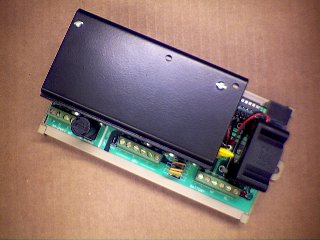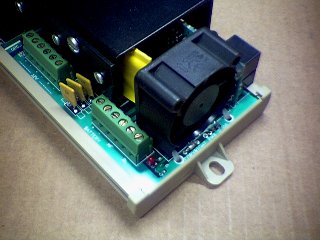12 Volt 3.5 Amp : Smart Power Supply
|
|||
|
3.5A continuous, 5A peak |
DIN Rail Mounting option |
||
|
3 self resetting PTC fused outputs |
Smart battery testing and mains fail detection |
||
|
90 to 250V AC Input |
Mains-Fail and Battery-Fail outputs |
||
|
Details - Current Rating - Features - Caution - Prices - Notes |
|||
. Designed for the security industry. Ideal for any application requiring up to 3.5A continuous with battery backup and status monitoring. A FEW DETAILSINTRODUCTIONThis is an off-line switch-mode power supply. It does not need a mains power transformer. It takes 90-250 VAC mains power in, and provides a nominal 12V DC output at up to 3.5 amps continuous, 5 amps peak. This output is battery backed. The power supply looks after the battery, charging, monitoring and testing it occasionally. There are 2 clean contact relay outputs that report Mains Fail, and Battery Low. Mains Fail is just that, it activates on a mains power failure and also on a main power supply failure. The relay operates 60 seconds after the mains power fails, or immediately if there is no battery connected. The Battery Low relay operates when the battery voltage becomes dangerously low and when the battery capacity appears to be failing. Two LED's indicates, Normal (green or green flashing), Mains Fail (red slow flashing) and Battery Low (red fast flashing). The power supply monitors the battery voltage and the output voltage. Every so often the charge voltage is reduced and the battery is allowed to supply the load. The battery voltage is monitored and an estimation made of the battery capacity. This is compared with the last few tests. If it reduces by too much the Battery Low relay is operated. PTC (Resettable) FUSINGThere are three outputs, each individually protected by a PTC, rated at 1.6 Amps. There is a jumper that can be inserted to combine the first and second outputs, increasing the rating on a single connection to 3A. If all three outputs are linked together, the continuous load current can exceed 3 Amps. A PTC is often referred to as a resettable fuse. They are in effect a heat activated fuse. When the current exceeds their rating they get hot and effectively open circuit. They stay hot until the load is removed and they are allowed to cool. There are a few disadvantages. If they trip, the load must be removed while they cool, so they are not fully automatically resetting. They are very slow to operate compared to a small fast blow glass fuse. A PTC with a 150% overload can take 5 minutes or more to trip. Their rating is also affected by ambient temperature. As the temperature goes up, the trip current comes down. PTCs are ideal for protecting individual circuits at a power distribution point. Their ability to withstand reasonable short term overloads is an advantage. WHAT DOES "12V nominal" MEANBasically it means that the output voltage is approximately 12 volts. Because the power supply provides battery backup to the output, the actual voltage will depend on the mains power and the battery voltage. When the mains power is on, the output comes from the power supply, which produces about 14 volts to keep the battery charged. When the mains power fails or is switched off, the output comes from the battery. The battery voltage will depend on the age or condition of the battery, the load current, and the state of charge on the battery. The battery will normally be a sealed lead-acid type. These are considered flat at about 10.8 volts and should not be discharged below this point. Deep discharge will permanently reduce the battery capacity. What all this means is that with the mains power on, the output voltage will be up around 13.8 to 14 volts. With the mains power off, the output voltage will gradually drop to around 10 volts as the battery goes flat. Any good equipment designed to be 12V battery powered will operate normally down to 10 volts. Security, Access Control and similar installations will also have to consider the volt-drop in long cable runs. Many door locking devices fail to operate correctly even with a small voltage reduction. Magnetic clamps reduce holding force and solenoid based locks become unreliable or fail altogether. These shortcomings can cause a serious lack of security that is overlooked by many system designers. CURRENT RATINGThe continuous output current rating is limited mainly by temperature rise in a relatively confined space. The standard unit has a small fan which moves air slowly through the interior. The additional airflow reduces the operating temperature, which makes the continuous current rating 3.5 Amps. The unit will supply 5 Amps peak for short periods; typically a few minutes. Because fan life and reliability is an important issue, the fan is run at a slightly reduced speed and only when required. The fan is temperature controlled. Combined, these features ensure best possible life expectancy. Continuous & Peak Current RatingThe continuous and peak current ratings are accurate, unlike many linear power supplies that can only be operated reliably at 50% to 60% of their rating long term. The switchmode design provides maximum efficiency which results in minimum heat generation.
FEATURES
CAUTION - DANGER
Do
not dis-assemble this unit, LETHAL VOLTAGES INSIDE. |
|||

